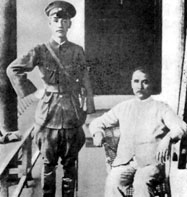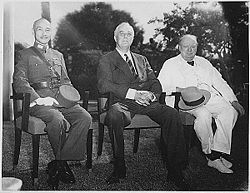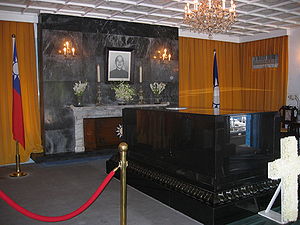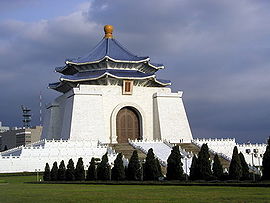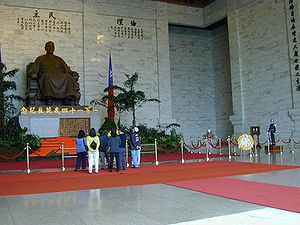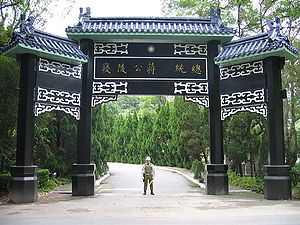Difference between revisions of "Chiang Kai-shek" - New World Encyclopedia
Mary Anglin (talk | contribs) m (intro) |
Mary Anglin (talk | contribs) (move item) |
||
| Line 48: | Line 48: | ||
Like Sun Yat-sen, Chiang left an incomplete legacy. Personally ascetic, he allowed corruption to flourish. A darling of Western democrats, he imposed martial law on Taiwan—though after his 1975 death his son and successor Chiang Ching-kuo eventually lifted it. Like Sun, he tried and failed to unify a divided nation. But unlike his predecessor, Chiang Kai-shek left behind a prosperous economy that grew into a genuine democracy. [[http://www.time.com/time/asia/asia/magazine/1999/990823/cks.html]] | Like Sun Yat-sen, Chiang left an incomplete legacy. Personally ascetic, he allowed corruption to flourish. A darling of Western democrats, he imposed martial law on Taiwan—though after his 1975 death his son and successor Chiang Ching-kuo eventually lifted it. Like Sun, he tried and failed to unify a divided nation. But unlike his predecessor, Chiang Kai-shek left behind a prosperous economy that grew into a genuine democracy. [[http://www.time.com/time/asia/asia/magazine/1999/990823/cks.html]] | ||
| − | == | + | ==Personal life== |
Chiang Kai-shek was born in the town of [[Xikou]], approximately 33 km (20.5 miles) southwest of downtown Ningbo, in [[Fenghua]] [[County-level city|County]], [[Ningbo]] [[Prefecture-level city|Prefecture]], [[Zhejiang]] [[Province of China|Province]]. However, his [[ancestral home]] (祖籍), a concept important in Chinese society, was the town of Heqiao (和橋鎮) in [[Yixing]] County, [[Wuxi]] Prefecture, [[Jiangsu]] Province (approximately 38 km or 24 miles southwest of downtown Wuxi, and 10 km. or 6 miles from the shores of the famous [[Lake Taihu]]). | Chiang Kai-shek was born in the town of [[Xikou]], approximately 33 km (20.5 miles) southwest of downtown Ningbo, in [[Fenghua]] [[County-level city|County]], [[Ningbo]] [[Prefecture-level city|Prefecture]], [[Zhejiang]] [[Province of China|Province]]. However, his [[ancestral home]] (祖籍), a concept important in Chinese society, was the town of Heqiao (和橋鎮) in [[Yixing]] County, [[Wuxi]] Prefecture, [[Jiangsu]] Province (approximately 38 km or 24 miles southwest of downtown Wuxi, and 10 km. or 6 miles from the shores of the famous [[Lake Taihu]]). | ||
| + | ===Youth and Education=== | ||
His parents were Chiang Zhaocong (蔣肇聰) and Wang Caiyu (王采玉), part of an upper-middle class family of [[salt]] merchants. His father died when he was only three, and he wrote of his mother as the "embodiment of Confucian virtues." In an [[arranged marriage]], Chiang was married to fellow villager Mao Fumei<sup>[[#Notes|1]]</sup> (毛福梅, 1882–1939). Chiang and Mao had a son [[Chiang Ching-Kuo|Ching-Kuo]] and a daughter Chien-hua (建華). | His parents were Chiang Zhaocong (蔣肇聰) and Wang Caiyu (王采玉), part of an upper-middle class family of [[salt]] merchants. His father died when he was only three, and he wrote of his mother as the "embodiment of Confucian virtues." In an [[arranged marriage]], Chiang was married to fellow villager Mao Fumei<sup>[[#Notes|1]]</sup> (毛福梅, 1882–1939). Chiang and Mao had a son [[Chiang Ching-Kuo|Ching-Kuo]] and a daughter Chien-hua (建華). | ||
Chiang grew up in an era in which military defeats had left [[China]] destabilized and in debt, and he decided to join the military. He began his military education at the [[Paoting Military Academy]] in 1906. He left for the [[Shimbu Gakko|Military State Academy]] in [[Japan]] in 1907. There he was influenced by his compatriots to support the revolutionary movement to overthrow the [[Qing Dynasty]] and to set up a Chinese republic. He befriended fellow Zhejiang native [[Chen Qimei]], and in 1908 Chen brought Chiang to the [[Revolutionary Alliance]]. Chiang served in the [[Imperial Japanese Army]] from 1909 to 1911. | Chiang grew up in an era in which military defeats had left [[China]] destabilized and in debt, and he decided to join the military. He began his military education at the [[Paoting Military Academy]] in 1906. He left for the [[Shimbu Gakko|Military State Academy]] in [[Japan]] in 1907. There he was influenced by his compatriots to support the revolutionary movement to overthrow the [[Qing Dynasty]] and to set up a Chinese republic. He befriended fellow Zhejiang native [[Chen Qimei]], and in 1908 Chen brought Chiang to the [[Revolutionary Alliance]]. Chiang served in the [[Imperial Japanese Army]] from 1909 to 1911. | ||
| + | |||
| + | ===Marriages=== | ||
| + | #While married to Mao, Chiang adopted two [[concubine]]s: he married [[Yao Yecheng]] (姚冶誠, [[1889]]-[[1972]]) in [[1912]] and [[Chen Jieru]] (陳潔如, [[1906]]-[[1971]]) in December [[1921]]. Yao raised the adopted [[Chiang Wei-kuo|Wei-kuo]]. Chen had a daughter in [[1924]], named Yaoguang (瑤光), who later adopted her mother's surname. (It should be noted that Chen's autobiography disclaimed the idea that she was a concubine and claimed that by the time she married Chiang, he had already been divorced from Mao, and that therefore she was a wife.) | ||
| + | <gallery> | ||
| + | Image:Mao Fumei.jpg|Mao Fumei (毛福梅, 1882-1939) Died in the [[Second Sino-Japanese War]] during a bombardment. | ||
| + | Image:Yao Zhicheng.jpg|Yao Yecheng (姚冶誠, 1889-1972) Fled to [[Taiwan]] and died in [[Taipei]]. | ||
| + | Image:Chen Jieru.jpg|Chen Jieru (陳潔如, 1906-1971) Lived in [[Shanghai]]. Moved to [[Hong Kong]] later and died there. | ||
| + | </gallery> | ||
| + | |||
== Rise to power == | == Rise to power == | ||
| Line 146: | Line 156: | ||
* [[History of the Republic of China]] | * [[History of the Republic of China]] | ||
* [[Chiang Kai-shek Memorial Song]] | * [[Chiang Kai-shek Memorial Song]] | ||
| − | |||
| − | |||
| − | |||
| − | |||
| − | |||
| − | |||
| − | |||
| − | |||
==Further reading== | ==Further reading== | ||
Revision as of 01:05, 20 July 2006
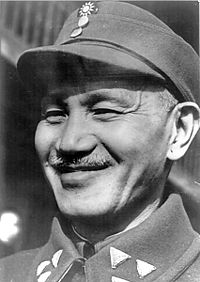
| |
| Names (details) | |
|---|---|
| Known in English as: | Chiang Kai-shek |
| Known in mainland China as: | 蔣介石 |
| Hanyu Pinyin: | Jiǎng Jièshí |
| Wade-Giles: | Chiang Chieh-shih |
| Known in Taiwan as: | 蔣中正 |
| Hanyu Pinyin: | Jiǎng Zhōngzhèng |
| Wade-Giles: | Chiang Chung-cheng |
| Family name: | Jiang |
| Traditional Chinese: | 蔣 |
| Simplified Chinese: | 蒋 |
| Given | names |
| Register name (譜名): | Zhoutai (周泰) |
| Milk name (乳名): | Ruiyuan (瑞元) |
| School name (學名): | Zhiqing (志清), |
| later Zhongzheng (中正) | |
| Courtesy name (字): | Jieshi (介石) |
| Kai-shek in Cantonese | |
Chiang Kai-shek (October 31, 1887 – April 5, 1975) was a Chinese military and political leader who assumed the leadership of the Kuomintang (KMT) after the death of Sun Yat-sen in 1925. He commanded the Northern Expedition to unify China against the warlords and emerged victorious in 1928 as the overall leader of the Republic of China (ROC). Chiang led China in the Second Sino-Japanese War, during which his stature within China weakened but his international prominence grew. During the Chinese Civil War (1926–1949), Chiang attempted to eradicate the Chinese Communists but ultimately failed, forcing his government to retreat to Taiwan, where he continued serving as the President of the Republic of China and Director-General of the KMT for the remainder of his life.
Known as a zealous patriot, Chiang moved from military to political leader and back again with ease. His original goal was the modernization of China, yet the constancy of war during his tenure dictated his effectivenesss. Chiang had dreams of national glory informed by the harsh realities of his youth. Born in 1887 in a remote farm village in the eastern province of Zhejiang, he began working at the age of nine after his father died.
"Organization of the people's army", "establishment of a government of integrity" and "indemnify the rights of agricultural and industrial organizations" were slogans he used. He did not accomplish his goals of a unified and prosperous mainland China, but his leadership in Taiwan evoked loyalty and love of country in the hearts of the people. [[1]]
Like Sun Yat-sen, Chiang left an incomplete legacy. Personally ascetic, he allowed corruption to flourish. A darling of Western democrats, he imposed martial law on Taiwan—though after his 1975 death his son and successor Chiang Ching-kuo eventually lifted it. Like Sun, he tried and failed to unify a divided nation. But unlike his predecessor, Chiang Kai-shek left behind a prosperous economy that grew into a genuine democracy. [[2]]
Personal life
Chiang Kai-shek was born in the town of Xikou, approximately 33 km (20.5 miles) southwest of downtown Ningbo, in Fenghua County, Ningbo Prefecture, Zhejiang Province. However, his ancestral home (祖籍), a concept important in Chinese society, was the town of Heqiao (和橋鎮) in Yixing County, Wuxi Prefecture, Jiangsu Province (approximately 38 km or 24 miles southwest of downtown Wuxi, and 10 km. or 6 miles from the shores of the famous Lake Taihu).
Youth and Education
His parents were Chiang Zhaocong (蔣肇聰) and Wang Caiyu (王采玉), part of an upper-middle class family of salt merchants. His father died when he was only three, and he wrote of his mother as the "embodiment of Confucian virtues." In an arranged marriage, Chiang was married to fellow villager Mao Fumei1 (毛福梅, 1882–1939). Chiang and Mao had a son Ching-Kuo and a daughter Chien-hua (建華).
Chiang grew up in an era in which military defeats had left China destabilized and in debt, and he decided to join the military. He began his military education at the Paoting Military Academy in 1906. He left for the Military State Academy in Japan in 1907. There he was influenced by his compatriots to support the revolutionary movement to overthrow the Qing Dynasty and to set up a Chinese republic. He befriended fellow Zhejiang native Chen Qimei, and in 1908 Chen brought Chiang to the Revolutionary Alliance. Chiang served in the Imperial Japanese Army from 1909 to 1911.
Marriages
- While married to Mao, Chiang adopted two concubines: he married Yao Yecheng (姚冶誠, 1889-1972) in 1912 and Chen Jieru (陳潔如, 1906-1971) in December 1921. Yao raised the adopted Wei-kuo. Chen had a daughter in 1924, named Yaoguang (瑤光), who later adopted her mother's surname. (It should be noted that Chen's autobiography disclaimed the idea that she was a concubine and claimed that by the time she married Chiang, he had already been divorced from Mao, and that therefore she was a wife.)
- Mao Fumei.jpg
Mao Fumei (毛福梅, 1882-1939) Died in the Second Sino-Japanese War during a bombardment.
- Yao Zhicheng.jpg
Yao Yecheng (姚冶誠, 1889-1972) Fled to Taiwan and died in Taipei.
Rise to power
With the outbreak of the Wuchang Uprising in 1911, Chiang Kai-shek returned to China to fight in the revolution as an artillery officer. He served in the revolutionary forces, leading a regiment in Shanghai under his friend and mentor Chen Qimei. The revolution was ultimately successful in overthrowing the Qing Dynasty and Chiang became a founding member of the Kuomintang.
After takeover of the Republican government by Yuan Shikai and the failed Second Revolution, Chiang, like his Kuomintang comrades, divided his time between exile in Japan and haven in Shanghai's foreign concession areas. In Shanghai, Chiang also cultivated ties with the criminal underworld dominated by the notorious Green Gang and its leader Du Yuesheng. Chiang had numerous brushes with the law during this period and the International Concession police records show an arrest warrant for him for armed robbery. On February 15, 1912, Chiang Kai-shek shot and killed Tao Chengzhang, the leader of the Restoration Society, at point-blank range as Tao lay sick in a Shanghai French Concession hospital, thus ridding Chen Qimei of his chief rival. In 1915, Chen Qimei was assassinated by agents of Yuan Shikai and Chiang succeeded him as the leader of the Chinese Revolutionary Party in Shanghai. This was during a low point in Sun Yat-sen's career, with most of his old Revolutionary Alliance comrades refusing to join him in the exiled Chinese Revolutionary Party, and Chen Qimei had been Sun's chief lieutenant in the party.
In 1917 Sun Yat-sen moved his base of operations to Guangzhou and Chiang joined him in 1918. Sun, at the time was largely sidelined and without arms or money, was soon expelled from Guangzhou in 1918 and exiled again to Shanghai, but restored again with mercenary help in 1920. However, a rift had developed between Sun, who sought to militarily unify China under the KMT, and Guangdong Governor Chen Jiongming, who wanted to implement a federalist system with Guangdong as a model province. On June 16, 1923, Chen attempted to expel Sun from Guangzhou and had his residence shelled. Sun and his wife Song Qingling narrowly escaped under heavy machine gun fire, only to be rescued by gunboats under the direction of Chiang Kai-shek. The incident earned in Chiang Kai-shek the trust of Sun Yat-sen.
Sun regained control in Guangzhou in early 1924 with the help of mercenaries from Yunnan, and accepted aid from the Comintern. He then undertook a reform of the Kuomintang and established a revolutionary government aimed at unifying China under the KMT. That same year, Sun sent Chiang Kai-shek to spend three months in Moscow studying the Soviet political and military system. Chiang left his eldest son Ching-kuo in Russia, who would not return until 1937. Chiang Kai-shek returned to Guangzhou and in 1924 was made Commandant of the Whampoa Military Academy. The early years at Whampoa allowed Chiang to cultivate a cadre of young officers loyal to him and by 1925 Chiang's proto-army was scoring victories against local rivals in Guangdong province. Here he also first met and worked with a young Zhou Enlai, who was selected to be Whampoa's Political Commissar. However, Chiang was deeply critical of the Kuomintang-Communist Party United Front, suspicious that the Communists would take over the KMT from within.
With Sun Yat-sen's death in 1925 a power vacuum developed in the KMT. A power struggle ensued between Chiang, who leaned towards the right wing of the KMT, and Sun Yat-sen's close comrade-in-arms Wang Jingwei, who leaned towards the left wing of the party. Though Chiang ranked relatively low in the civilian hierarchy, and Wang had succeeded Sun to power as Chairman of the National Government, Chiang's deft political maneuvering eventually allowed him to emerge victorious. Chiang, who became Commander-in-Chief of the National Revolutionary Forces in 1925, launched in July 1926 the Northern Expedition, a military campaign to defeat the warlords controlling northern China and unify the country under the KMT.
The National Revolutionary Army branched into three divisions—to the west, Wang Jingwei led a column to take Wuhan, to the east, Pai Ch'ung-hsi led another column to take Shanghai, while Chiang led in the middle to take Nanjing—before they were to press ahead to take Beijing. However, in January [1927, allied with the Chinese Communists and Soviet Agent Mikhail Borodin, Wang Jingwei and his KMT leftist allies (including Hu Hanmin and Song Qingling), having taken the city of Wuhan amid much popular mobilization and fanfare, declared the National Government to have moved to Wuhan. After taking Nanjing in March (and with Shanghai under the control of his close ally General Pai), Chiang momentarily halted his campaign and decided to break with the leftists. On April 12, Chiang began a swift and brutal attack on thousands of suspected Communists. He then established his own National Government in Nanjing, supported by his conservative allies. The communists were purged from the KMT and the Soviet advisers were expelled. This earned Chiang the support (and financial backing) of the Shanghai business community, and maintained him the loyalty of his Whampoa officers (many of whom hailed from Hunan elites were discontented by the land redistribution Wang Jingwei was enacting in the area), but led to the beginning of the Chinese Civil War. Wang Jingwei's National Government, though popular with the masses, was weak militarily and was soon overtaken by a local warlord, forcing Wang and his leftist government into joining him in Nanjing. Finally, the warlord capital of Beijing was taken in June 1928 and in December, the Manchurian warlord Chang Hsueh-liang pledged allegiance to Chiang's government.
Chiang made gestures to cement himself as the successor of Sun Yat-sen. In a pairing of much political significance, Chiang married on December 1, 1927 Soong May-ling, the younger sister of Soong Ching-ling (Sun Yat-sen's widow, whom he had proposed to beforehand but was swiftly rejected) in Japan and thus positioned himself as Sun Yat-sen's brother-in-law. (To please Soong's parents, Chiang had to first divorce his first wife and concubines and promise eventually to convert to Christianity. He was baptized in 1929.) Upon reaching Beijing, Chiang paid homage to Sun Yat-sen and had his body moved to the capital Nanjing to be enshrined in an grand mausoleum.
"Tutelage" over China
Chiang Kai-shek gained nominal control of China, but his party was "too weak to lead and too strong to overthrow". In 1928, Chiang was named Generalissimo of all Chinese forces and Chairman of the National Government, a post he held until 1932 and later from 1943 until 1948. According to KMT political orthodoxy, this period thus began the period of "political tutelage" under the dictatorship of the Kuomintang.
The decade of 1928 to 1937 was one of consolidation and accomplishment for Chiang's government. Some of the harsh aspects of foreign concessions and privileges in China were moderated through diplomacy. The government acted energetically to modernize the legal and penal systems, stabilize prices, amortize debts, reform the banking and currency systems, build railroads and highways, improve public health facilities, legislate against traffic in narcotics, and augment industrial and agricultural production. Great strides also were made in education and, in an effort to help unify Chinese society—the New Life Movement was launched to stress Confucian moral values and personal discipline. Mandarin was promoted as a standard tongue. The widespread establishment of communications facilities further encouraged a sense of unity and pride among the people.
These successes, however, were met with constant upheavals with need of further political and military consolidation. Though much of the urban areas were now under the control of his party, the countryside still lay under the influence of severely weakened yet undefeated warlords and communists. Chiang fought with most of his warlord allies, with one northern rebellion—against the warlords Yen Hsi-shan and Feng Yuxiang—in 1930 almost bankrupting the government and costing almost 250,000 casualties. When Hu Han-min established a rival government in Guangzhou in 1931, Chiang's government was nearly toppled. A complete eradication of the Communist Party of China eluded Chiang. The Communists regrouped in Jiangxi and established the Chinese Soviet Republic. Chiang's anti-communist stance attracted the aid of German military advisers, and in Chiang's fifth campaign to defeat the Communists in 1934, he surrounded the Red Army only to see the Communists escape through the epic Long March to Yan'an.
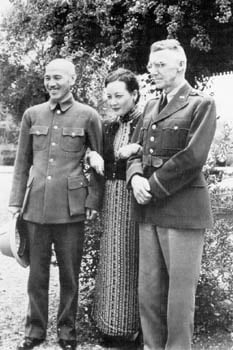
Wartime leader of China
After Japan's invasion of Manchuria in 1931, Chiang resigned as Chairman of the National Government. He returned shortly, adopting a slogan "first internal pacification, then external resistance", which meant that the government would first attempt to defeat the Communists before engaging in the Japanese directly. But Japan's advance on Shanghai and bombardment of Nanjing in 1932 disrupted Chiang Kai-shek's offensives against Communists. Though it continued for several years, the policy of appeasing Japan and avoiding war was widely unpopular. In December 1936, Chiang flew to Xi'an to coordinate a major assault on Red Army forces holed up in Yan'an. However, Chiang's allied commander Chang Hsueh-liang, whose forces were to be used in his attack and whose homeland of Manchuria had been invaded by the Japanese, had other plans. On December 12, Chang Hsueh-liang and several other Nationalist generals kidnapped Chiang Kai-shek for two weeks in what is known as the Xi'an Incident. They forced Chiang into making a "Second United Front" with the Communists against Japan. Though he lost his chance to finish off the communists, Chiang refused to make a formal public announcement of this "United Front" as many had hoped and his troops continued fighting the Communists throughout the war.
All-out war with Japan broke out in July 1937. In August of the same year, Chiang sent 500,000 of his best trained and equipped soldiers to defend Shanghai. With about 250,000 Chinese casualties, Chiang lost his political base of Whampoa-trained officers. Although Chiang lost militarily, the battle dispelled Japanese claims that it could conquer China in three months and demonstrated to the Western powers (which occupied parts of the city and invested heavily in it) that the Chinese would not surrender under intense Japanese fire. This was skillful diplomatic maneuvering on the part of Chiang, who knew the city would eventually fall, but wanted to make a strong gesture in order to secure Western military aid for China. By December, the capital city of Nanjing had fallen to the Japanese and Chiang moved the government inland to Chongqing. Devoid of economic and industrial resources, Chiang could not counter-attack and held off the rest of the war preserving whatever territory he still controlled, though his strategy succeeded in stretching Japanese supply lines and bogging down Japanese soldiers in the vast Chinese interior who would otherwise have been sent to conquer southeast Asia and the Pacific islands.
With the Attack on Pearl Harbor and the opening of the Pacific War, China became one of the Allied Powers. During and after World War II, Chiang and his American-educated wife Soong May-ling, commonly referred to as "Madame Chiang Kai-shek", held the unwavering support of the United States China Lobby which saw in them the hope of a Christian and democratic China. Chiang Kai-shek's policies were far from Christian or democratic, but this remained unknown to the U.S. public due to strong state-imposed censorship in China and self-imposed censorship in the U.S. during the war years and after. This was especially fomented by the Chiangs' close friendship with TIME magazine publisher Henry Luce.
Chiang's strategy during the War opposed the strategies of both Mao Zedong and the United States. The U.S. regarded Chiang as an important ally able to help shorten the war by engaging the Japanese occupiers in China. Chiang, in contrast, used powerful associates such as H. H. Kung in Hong Kong to build the ROC army for certain conflict with the communist forces after the end of WWII. This fact was not understood well in the United States. The U.S. liaison officer, General Joseph Stilwell, correctly deduced that Chiang's strategy was to accumulate munitions for future civil war rather than fight the Japanese, but Stilwell was unable to convince Franklin D. Roosevelt of this and precious Lend-Lease armaments continued to be allocated to the Kuomintang. Chiang was recognized as one of the "Big Four" Allied leaders along with Roosevelt, Churchill, and Stalin and travelled to attend the Cairo Conference in November 1943. His wife acted as his translator and adviser.
"Losing China"
When Japan surrendered in 1945, Chiang's Chonqing government was ill-equipped to reassert its authority in eastern China. It was able to reclaim the coastal cities with American assistance, and sometimes those of former puppet and Japanese troops, a deeply unpopular move. The countryside in the north was already largely under the control of the Communists, whose forces were better motivated and disciplined than those of the KMT.
Following the war, the United States had encouraged peace talks between Chiang and Communist leader Mao Zedong in Chongqing. Distrustful of each other and of the United States' professed neutrality, they soon resorted to all-out war. The U.S. suspended aid to Chiang Kai-shek for much of the period of 1946 to 1948, in the midst of fighting against the People's Liberation Army led by Mao Zedong. Though Chiang had achieved status abroad as a world leader, his government was deteriorating with corruption and inflation. The war had severely weakened the Nationalists both in terms of resources and popularity while the Communists were strengthened by aid from Stalin, and guerrilla organizations extending throughout rural areas. The Nationalists initially had superiority in arms and men, but their lack of popularity and morale, and apparent disorganization soon allowed the Communists to gain the upper hand.
Meanwhile a new Constitution promulgated in 1947], and Chiang was elected by the National Assembly to be President. This marked the beginning of the democratic constitutional government period in KMT political orthodoxy, but the Communists refused to recognize the new Constitution and its government as legitimate.
Chiang resigned as President on January 21, 1949, as KMT forces suffered massive losses against the communists. Vice President Li Tsung-jen took over as Acting President, but his relationship with Chiang soon deteriorated, as Chiang still acted as if he were in power, and Li was forced into exile in the United States under a medical excuse (under Chiang's direction, Li was later formally impeached by the Control Yuan). In the early morning of December 10, 1949, Communist troops laid siege to Chengdu, the last KMT occupied city in mainland China, where Chiang Kai-shek and his son Chiang Ching-kuo directed the defense at the Chengdu Central Military Academy. The aircraft May-ling evacuated them to Taiwan on the same day, forever removing them from the Chinese mainland.
Presidency in Taiwan
Chiang moved his government to Taipei, Taiwan, where he formally resumed his duties as president on March 1, 1950. Chiang was reelected by the National Assembly to be the President of the ROC on May 20, 1954 and later on in 1960, 1966, and 1972. In this position he continued to claim sovereignty over all of China. In the context of the Cold War, most of the Western world recognized this position and the ROC represented China in the United Nations and other international organizations until the 1970s.
Despite the democratic constitution, the government under Chiang was a repressive and authoritarian single-party state consisting almost completely of non-Taiwanese mainlanders; the "Temporary Provisions Effective During the Period of Communist Rebellion" greatly enhanced executive power and the goal of "retaking the mainland" allowed the KMT to maintain its monopoly on power and to outlaw opposition parties. The government's official line for these provisions stemmed from the claim that emergency provisions were necessary, since the Communists and KMT were still technically under a state of war, without any cease-fire signed, after Chiang retreated to Taiwan. His government sought to impose Chinese nationalism and repressed the local culture, such as by forbidding the use of Taiwanese in mass media broadcasts or in schools. The government permitted free debate within the confines of the legislature, but jailed dissidents who were either labelled as supporters of Chinese communism or Taiwan independence. His son Chiang Ching-kuo and Chiang Ching-kuo's successor Lee Teng-hui would in the [1980s and 1990s increase native Taiwanese representation in the government and loosen the many authoritarian controls of the Chiang Kai-shek era.
Since new elections could not be held in their Communist-occupied constituencies, the members of the KMT-dominated National Assembly, Legislative Yuan, and Control Yuan held their posts indefinitely. It was under the Temporary Provisions that Chiang was able to bypass term limits to remain as president. He was reelected (unopposed) by the National Assembly as president four times in 1954, 1960, 1966, and 1972.
Defeated by the Communists, Chiang purged members of the KMT previously accused of corruption, and major figures in the previous mainland government such as H.H. Kung and T.V. Soong exiled themselves to the United States. Though the government was politically authoritarian and controlled key industries, it encouraged economic development, especially in the export sector. A sweeping Land Reform Act, as well as American foreign aid during the 1950's laid the foundation for Taiwan's economic success, becoming one of the East Asian Tigers.
When the uniform numbers of the National Identification Cards of the Republic of China (中華民國國民身分證) started to be coded in 1965, the bearer of the number 1 ID Card was Chiang Kai-shek, coded Y10000001.
Death and legacy
In 1975, 26 years after Chiang fled to Taiwan, he died in Taipei at the age of 87. He had suffered a major heart attack and pneumonia in the months before and died from renal failure aggravated with advanced cardiac malfunction at 23:50 on April 5.
A month of mourning was declared during which the Taiwanese people were asked to put on black armbands. Televisions ran in black-and-white while all banquets or celebrations were forbidden. On the mainland, however, Chiang's death was met with little apparent mourning and newspapers gave the brief headline "Chiang Kai-shek Has Died." Chiang's corpse was put in a copper coffin and temporarily interred at his favorite residence in Cihhu, Dasi, Taoyuan County. When his son Chiang Ching-kuo died in 1988, he was also entombed in a separate mausoleum in nearby Touliao (頭寮). The hope was to have both buried at their birthplace in Fenghua once the mainland was recovered. In 2004, Chiang Fang-liang, the widow of Chiang Ching-kuo, asked that both father and son be buried at Wuchih Mountain Military Cemetery in Sijhih, Taipei County. The state funeral ceremony is planned to take place during the spring of 2006. Chiang Fang-liang and Soong May-ling had agreed in 1997 that the former leaders be first buried but still be moved to mainland China in the event of reunification.
Chiang was succeeded as President by Vice President Yen Chia-kan and as KMT party leader by his son Chiang Ching-kuo, who retired Chiang Kai-shek's title of Director-General and instead assumed the position of Chairman.Yen Chia-kan's presidency was mainly symbolic, with real power held by Premier Chiang Ching-kuo, who became President after Yen's term ended three years later.
Chiang Kai-shek's current popularity in Taiwan is sharply divided among political lines, enjoying greater support among KMT voters and the mainlander population. However, he is largely unpopular among DPP supporters and voters. Since the democratization of the 1990s, his picture began to be removed from public buildings and currency, while many of his statues have been taken down; in sharp contrast to his son Ching-kuo and to Sun Yat-sen, his memory is rarely invoked by current political parties, including the Kuomintang.
Names
Like many other Chinese historical figures, Chiang Kai-shek used several names throughout his life. That inscribed in the genealogical records of his family is Jiang Zhoutai (蔣周泰). This so-called "register name" (譜名) is the one under which his extended relatives knew him, and the one he used in formal occasions, such as when he got married. Traditionally, the register name was not used in intercourse with people outside of the family, and in fact the concept of real or original name is not as clear-cut in China as it is in the Western world.
Traditionally, Chinese families waited a number of years before officially naming their offspring. In the meantime, they used a "milk name" (乳名), given to the infant shortly after his birth and known only to the close family. Thus, the actual name that Chiang Kai-shek received at birth was Jiang Ruiyuan (蔣瑞元).
In 1903, the 16-year-old Chiang Kai-shek went to Ningbo to be a student, and he chose a "school name" (學名). This was actually the formal name of a person, used by older people to address him, and the one he would use the most in the first decades of his life (as the person grew older, younger generations would have to use one of the courtesy names instead). (Colloquially, the school name is called "big name" (大名), whereas the "milk name" is known as the "small name" (小名).) The school name that Chiang Kai-shek chose for himself was Zhiqing (志清 - meaning "purity of intentions"). For the next fifteen years or so, Chiang Kai-shek was known as Jiang Zhiqing. This is the name under which Sun Yat-sen knew him when Chiang joined the republicans in Guangzhou in the 1910s.
In 1912, when Chiang Kai-shek was in Japan, he started to use Jiang Jieshi (蔣介石) as a pen name for the articles that he published in a Chinese magazine he founded (Voice of the Army - 軍聲). Jieshi soon became his courtesy name (字). Some think the name was chosen from the classic Chinese book the Book of Changes; other note that the first character of his courtesy name is also the first character of the courtesy name of his brother and other male relatives on the same generation line, while the second character of his courtesy name shi (石 - meaning "stone") suggests the second character of his "register name" tai (泰 - the famous Mount Tai of China). Courtesy names in China often bore a connection with the personal name of the person. As the courtesy name is the name used by people of the same generation to address the person, Chiang Kai-shek soon became known under this new name. (Jieshi is the pinyin romanization of the name, based on Mandarin, but the common romanized rendering is Kai-shek which is in Cantonese romanization. As the republicans were based in Guangzhou (a Cantonese speaking area), Chiang Kai-shek became known by Westerners under the Cantonese romanization of his courtesy name, while the family name as known in English seems to be the Mandarin pronunciation of his Chinese family name, transliterated in Wade-Giles). In mainland China, Jiang Jieshi is the name under which he is commonly known today.
Sometime in 1917 or 1918, as Chiang became close to Sun Yat-sen, he changed his name from Jiang Zhiqing to Jiang Zhongzheng (蔣中正). By adopting the name Zhongzheng ("central uprightness"), he was choosing a name very similar to the name of Sun Yat-sen, who was (and still is) known among Chinese as Zhongshan (中山 - meaning "central mountain"), thus establishing a link between the two. The meaning of uprightness, rectitude, or orthodoxy, implied by his name, also positioned him as the legitimate heir of Sun Yat-sen and his ideas. Not surprisingly, the Chinese Communists always rejected the use of this name, and it is not well known in mainland China. However, it was readily accepted by members of the Nationalist Party, and is the name under which Chiang Kai-shek is still officially known in Taiwan. Often, the name is shortened to Zhongzheng only (Chung-cheng in Wade-Giles), and passengers arriving at the Taipei airport are greeted by signs in Chinese welcoming them to the "Zhongzheng International Airport." Similarly, the largest monument in Taipei, the Chiang Kai-shek Memorial Hall is officially in Chinese called the "Zhongzheng Memorial Hall."
His name also used to be officially written in Taiwan as "The Late President (space) Lord Chiang" (先總統 蔣公), where the one-character-wide space showed respect; this practice lost its popularity after Taiwan's democratization in the 1990s. However, he is still known as Lord Chiang (without the title or space), along with the similarly positive name Jiang Zhongzheng, in Taiwan.
Chiang was also nicknamed "the Gimo" (short for "Generalissimo") by some English-speaking foreigners, especially by Americans during the Second World War.
See also
- History of the Republic of China
- Chiang Kai-shek Memorial Song
Further reading
- Crozier, Brian. The Man Who Lost China: ISBN 068414686X
- Fenby, Jonathan. Generalissimo Chiang Kai-Shek and the China he lost: 2003, The Free Press, ISBN 0-7432-3144-9
- Seagrave, Sterling. The Soong Dynasty: 1996, Corgi Books, ISBN 0-552-14108-9
External links
- ROC Government Biography
- Adoption of Chiang Kai-Shek (originally surnamed Zheng) into the Chiang Family
- Order of Generalissimo Chiang Kai-shek supplementing the Act of Surrender by Japan on September 9 1945
- 1937 Man and Wife of the Year
- Family tree of his descendants (in Simplified Chinese)
- 1966 GIO Biographical video
- Chiang Kai-shek Memorial Hall
- "The Memorial Song of Late President Chiang Kai-shek" (Ministry of National Defence of ROC)
- Chiang Kai-shek Biography From Spartacus Educational
- Annals of the Flying Tigers
| Preceded by: Wang Jingwei |
Chairman of the Central Executive Committee of Kuomintang 1933–1938 |
Succeeded by: none |
| Preceded by: none (KMT headed by Committee) |
Director-General of the Kuomintang 1938–1975 |
Succeeded by: Chiang Ching-kuo (Chairman of the Kuomintang) |
| Preceded by: Tan Yankai |
Chairman of the National Government 1928–1931 |
Succeeded by: Lin Sen |
| Preceded by: T.V. Soong |
Premier of the Republic of China 1930–1931 |
Succeeded by: Chen Mingshu |
| Preceded by: Wang Jingwei |
Premier of the Republic of China 1935–1938 |
Succeeded by: H. H. Kung |
| Preceded by: H. H. Kung |
Premier of the Republic of China 1939–1945 |
Succeeded by: Song Ziwen |
| Preceded by: Lin Sen |
Chairman of the National Government 1943–1948 |
Succeeded by: none (National Government abolished) |
| Preceded by: Song Ziwen |
Premier of the Republic of China 1947 |
Succeeded by: Zhang Qun |
| Preceded by: none (position established) |
President of the Republic of China May 20, 1948–January 21, 1949 |
Succeeded by: Li Tsung-jen (acting) |
| Preceded by: Li Tsung-jen (acting) |
President of the Republic of China March 1, 1950–April 5, 1975 |
Succeeded by: Yen Chia-kan |
| ||||||||||||||||||||||||||||||||||||||
zh-min-nan:Chiúⁿ Kài-se̍k bg:Чан Кай-ши cs:Čankajšek da:Chiang Kai-shek de:Chiang Kai-shek et:Jiang Jieshi es:Chiang Kai-shek eo:Jiang Jieshi fr:Tchang Kaï-chek gl:Chiang Kai Chek ko:장제스 id:Chiang Kai-shek it:Chiang Kai-shek he:צ'יאנג קאי שק hu:Csang Kaj-sek nl:Chiang Kai-shek ja:蒋介石 no:Chiang Kai-Shek pl:Chiang Kai-shek pt:Chiang Kai-shek ru:Чан Кайши sl:Čang Kaj-Šek fi:Jiang Jieshi sv:Chiang Kai-shek zh:蔣中正
Credits
New World Encyclopedia writers and editors rewrote and completed the Wikipedia article in accordance with New World Encyclopedia standards. This article abides by terms of the Creative Commons CC-by-sa 3.0 License (CC-by-sa), which may be used and disseminated with proper attribution. Credit is due under the terms of this license that can reference both the New World Encyclopedia contributors and the selfless volunteer contributors of the Wikimedia Foundation. To cite this article click here for a list of acceptable citing formats.The history of earlier contributions by wikipedians is accessible to researchers here:
The history of this article since it was imported to New World Encyclopedia:
Note: Some restrictions may apply to use of individual images which are separately licensed.
